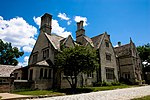Shady Side Academy is an independent preparatory school located in the Borough of Fox Chapel (suburban Pittsburgh), and in the Point Breeze neighborhood of Pittsburgh, Pennsylvania. Founded in 1883 as an all-male night school in the Shadyside neighborhood of Pittsburgh, the academy now offers a secular coeducational PK–12 program on four campuses in the city and its suburbs, including a boarding program in the Croft and Morewood Houses of its Senior School Campus.Formed to provide for the education of the sons of newly moneyed industrialists of Pittsburgh's East End, the academy counts the Frick and Mellon families among its early patrons. In 1922 the academy expanded to its sprawling Georgian Senior School campus in the then-countryside of Fox Chapel under the influence of the Country Day School movement. The academy merged with the Arnold School in 1940 to form its Junior School campus and added its stone Tudor manor-style Middle School campus in 1958, emerging in its current three-school system. The academy admitted its first female students in 1973. The school has in recent years demonstrated a vigorous commitment to diversity and financial accessibility.Shady Side Academy enrolls approximately one thousand students annually and is a member of the National Association of Independent Schools and the Association of Boarding Schools. The school is a member of the Chewonki Foundation's Maine Coast Semester at Chewonki in Wiscasset, Maine, CITYterm at the Masters' School, and the High Mountain Institute's HMI Semester in Leadville, Colorado, and sends a significant number of students to both programs annually. The academy competes locally with Oakland Catholic High School, the Ellis School, the Winchester Thurston School, and Central Catholic High School, as well as regionally with schools such as The Kiski School and Sewickley Academy, and its lower schools are compared to local primary schools St. Edmund's Academy and the Falk Laboratory School. Historic rivals from the former Independent School Preparatory League (IPSL) include Western Reserve Academy, University School, Linsly School, Nichols School, Cranbrook Schools, and The Kiski School. The school's colors are navy blue and old gold.
Niche.com consistently ranks Shady Side Academy as the #1 Private K-12 School in the Pittsburgh Area.Shady Side Academy's mission is to "challenge students to think expansively, act ethically and lead responsibly."



